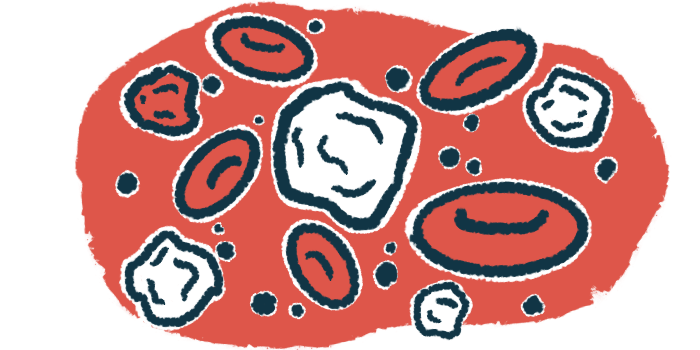Man’s CAD likely a complication of ICI cancer therapies
Immune-activating drugs suspected in delayed case of cold agglutinin disease
Written by |

In rare cases, cold agglutinin disease (CAD) may develop as a delayed complication of a combination of immune-activating cancer therapies called immune checkpoint inhibitors (ICIs), according to a case report.
While some cases of autoimmune hemolytic anemia (AIHA) — a group of autoimmune disorders that include CAD secondary to ICIs — have been reported, these autoimmune conditions usually developed while patients were still on cancer treatment.
In this case, however, the man showed signs of CAD more than two weeks after stopping ICI treatment, highlighting “the need for active and careful surveillance of late AIHA” in patients on ICIs, even after stopping treatment, the researchers wrote.
The case study, “Delayed cold-type autoimmune hemolytic anemia responding to Rituximab in a melanoma patient treated with Ipilimumab and Nivolumab,” was published in the form of a letter to the editor in the European Journal of Cancer.
AIHA refers to a group of rare autoimmune diseases in which the immune system produces self-reactive antibodies that attack and destroy red blood cells.
In CAD, these self-reactive antibodies, called cold agglutinins, attack the body’s own healthy red blood cells at low temperatures. This leads to anemia (low red blood cell counts), preventing the blood from transporting enough oxygen through the body and giving rise to symptoms such as fatigue.
CAD and other forms of AIHA can occur as a result of infections, cancer, and other autoimmune diseases. AIHAs have been reported previously as rare complications of ICIs, a type of cancer treatment that blocks immune checkpoints, or signaling pathways that work as brakes on immune responses.
Immune activation can lead to autoimmune reaction
Given that cancer cells use these pathways to evade destruction by the immune system, ICIs can activate the immune system to destroy the cancer. However, this immune activation also may lead to autoimmune reactions.
A previous review study reported that AIHA-related anemia presented, on average, six weeks (about 1.5 months) after beginning ICI treatment and was severe in all 10 reported cases.
Half of the patients had melanoma, a type of skin cancer, and all but two cases occurred in relation to Opdivo (nivolumab) and/or Yervoy (ipilimumab), two ICIs that target different immune checkpoints.
Now, a team of scientists in Italy described the unusual case of a 35-year-old man who developed CAD several weeks after stopping Yervoy plus Opdivo treatment for melanoma.
In February 2021, the man was diagnosed with advanced melanoma in is scalp, and he underwent several rounds of treatments. These included surgeries aiming to remove the tumor as well as several cancer medications, including another ICI called Keytruda (pembrolizumab) that did not lead to any immune-related adverse events.
Multiple cancer therapies
However, his cancer reappeared while on Keytruda, and he was treated with a combination of Yervoy and Opdivo from late 2022 through early 2023 before undergoing another surgery to remove the tumor.
He showed a partial response to the combo therapy, and his red blood cell counts were within normal ranges immediately after treatment, without any signs of red blood cell destruction (hemolysis).
Back in the ER, anemia and cold agglutinins detected
However, 27 days after finishing ICI treatment, the man went to the emergency room due to extreme fatigue. He had experienced generalized weakness and shortness of breath for four days.
Laboratory tests showed anemia, with very low red blood cell counts, and higher-than-normal levels of markers of hemolysis. Further tests also revealed the presence of cold agglutinins, confirming a diagnosis of CAD.
Given his clinical course, the combo ICI therapy was “considered as the most likely reason” of his CAD, the researchers wrote.
The man received immunosuppressive therapies for CAD: into-the-vein methylprednisolone at a dose of 1 mg/kg and rituximab at a dose of 660 mg, administered into the bloodstream three times over the course of three weeks.
The man responded well to this treatment, with resolution of several blood abnormalities as early as two weeks after starting therapy.
He then underwent a surgery to remove any remaining cancer cells, which was carried out successfully, and without the need for blood transfusion. Five months after the last rituximab dose, the man showed no more signs of CAD. At last follow-up he was still free from cancer spreading.
“Because of a rapid and efficient recovery of anemia, a timely radical surgery was achieved without the blood transfusion’s need, allowing a long-lasting clinical benefit,” the researchers wrote.
The team noted this case was original due to the delayed onset of CAD after: stopping Yervoy and Opdivo; its occurrence with combo ICI after treatment with a single, different ICI resulted in no immune-related adverse events; and rapid and long-term response to rituximab.
This case highlights that “clinicians should be aware of late-occurring AIHA even after stopping ICI treatment,” and even in patients with previous exposure to a single ICI, the team wrote.





